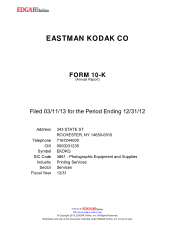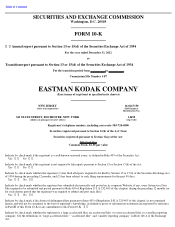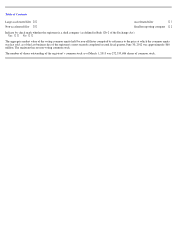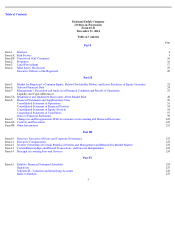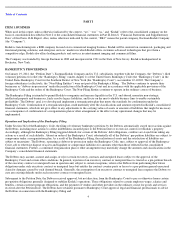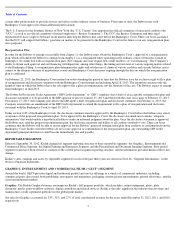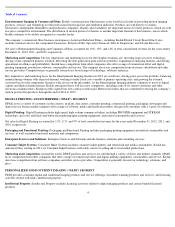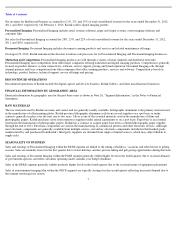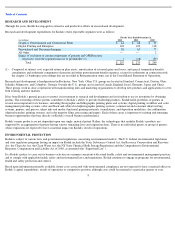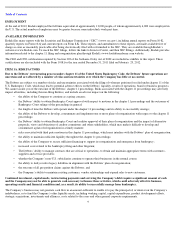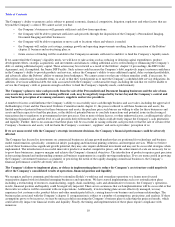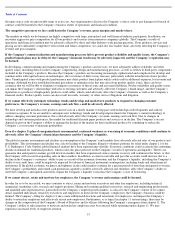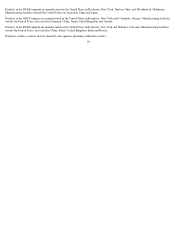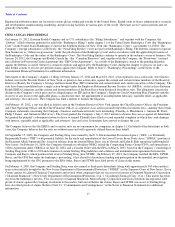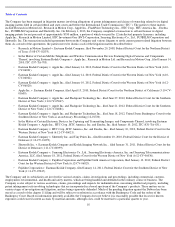Kodak 2012 Annual Report Download - page 11
Download and view the complete annual report
Please find page 11 of the 2012 Kodak annual report below. You can navigate through the pages in the report by either clicking on the pages listed below, or by using the keyword search tool below to find specific information within the annual report.
Table of Contents
The Company’s ability to generate cash is subject to general economic, financial, competitive, litigation, regulatory and other factors that are
beyond the Company’s control. We cannot assure you that:
If we cannot fund the Company’s liquidity needs, we will have to take actions such as reducing or delaying capital expenditures, product
development efforts, strategic acquisitions, and investments and alliances; selling additional assets; restructuring or refinancing the Company’s
debt; or seeking additional equity capital. These actions may be restricted as a result of the Debtors’ chapter 11 proceedings, the DIP Credit
Agreement, and, if completed, the Junior DIP Facility. Such actions could increase the Company’s debt, negatively impact customer confidence
in the Company’s ability to provide products and services, reduce the Company’s ability to raise additional capital, delay sustained profitability,
and adversely affect the Debtors’ ability to emerge from bankruptcy. We cannot assure you that any of these remedies could, if necessary, be
affected on commercially reasonable terms, or at all, or that they would permit us to meet the Company’s scheduled debt service obligations. In
addition, if we incur additional debt, the risks associated with the Company’s substantial leverage, including the risk that we will be unable to
service the Company’s debt or generate enough cash flow to fund the Company’s liquidity needs, could intensify.
The Company’s plans to raise cash proceeds from the sale of the Personalized and Document Imaging businesses and the sale of non-
core assets may not be successful in raising sufficient cash, may be negatively impacted by factors beyond the Company’s control and
may harm the perception of us among customers, suppliers and service providers.
A number of factors could influence the Company’s ability to successfully raise cash through business and asset sales, including the approval of
the Bankruptcy Court and the Unsecured Creditors Committee under chapter 11, the process utilized to sell these businesses and assets, the
limited number of potential buyers for these businesses and assets, the purchase price such buyers are willing to offer for these businesses and
assets and their capacity to fund the purchase, or the ability of potential buyers to conclude transactions and potential issues in the closing of
transactions due to regulatory or governmental review processes. One or more of these factors, or other unknown factors, could negatively affect
the timing of planned sales and the level of cash proceeds derived from the sales which could adversely impact the Company’s cash generation
and liquidity. Further, there is no assurance that these plans will be successful in raising sufficient cash proceeds or that the sale of certain of the
Company’s businesses and assets, will not harm the Company’s customers’, suppliers’ and service providers’ perception of us.
If we are unsuccessful with the Company’s strategic investment decisions, the Company’s financial performance could be adversely
affected.
The Company has focused its investments on commercial businesses in large growth markets that are positioned for technology and business
model transformation, specifically, commercial inkjet, packaging and functional printing solutions, and enterprise services. While we believe
each of these businesses has significant growth potential, they may also require additional investment and may not be successful strategies when
implemented. The introduction of successful innovative products at market competitive prices, and the achievement of scale are necessary for us
to grow these businesses, improve margins and achieve the Company’
s financial objectives. The introduction of products requires great precision
in forecasting demand and understanding commercial business requirements in a rapidly moving marketplace. If we are unsuccessful in growing
the Company’s investment businesses as planned, or perceiving the needs of the rapidly changing commercial businesses, the Company’s
financial performance could be adversely affected.
The Company’s failure to implement plans, or delays in implementing plans to reduce the Company’s cost structure could negatively
affect the Company’s consolidated results of operations, financial position and liquidity.
We recognize and have communicated the need to rationalize Kodak’s workforce and streamline operations to a leaner more focused
organization aligned with its identified emerging businesses and operations. We have started implementing such cost rationalization plans
including a restructuring of resources, manufacturing, supply chain, marketing, sales and administrative resources, the Company’s operations,
results, financial position and liquidity could be negatively impacted. There are no assurances that such implementation will be successful or that
the results we achieve will be consistent with our expectations. Additionally, if restructuring plans are not effectively managed, we may
experience lost customer sales, product delays and other unanticipated effects, causing harm to our business and customer relationships. The
business plan associated with the Company’s chapter 11 reorganization is subject to a number of assumptions, projections, and analysis. If these
assumptions prove to be incorrect, we may be unsuccessful in executing the Company’s business plan or achieving the projected results, which
could adversely impact our financial results and liquidity. Finally, the timing and implementation of these plans require compliance with
numerous
10
•
the Company
’
s businesses will generate sufficient cash flow from operations;
•
the Company will be able to generate sufficient cash proceeds through the disposition of the Company’s Personalized Imaging,
Document Imaging and other businesses;
•
the Company will be able to repatriate or move cash to locations where and when it is needed;
•
the Company will realize cost savings, earnings growth and operating improvements resulting from the execution of the Debtors’
chapter 11 business and restructuring plan; or
•
future sources of funding will be available to the Company in amounts sufficient to enable it to fund the Company
’
s liquidity needs.

